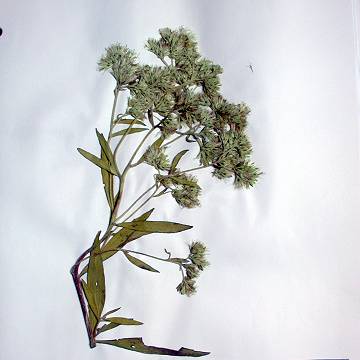

Kuhnia eupatoroides - (image 1 of 1)
Taxonomy
Family: Asteraceae
Habitat
Dry prairies, sandy oak savanna, often in sandy soil.
Associates
In prairies with Amorpha canescens, Andropogon gerardii, Andropogon scoparius, Arenaria stricta, Asclepias verticillata, Aster sericeus, Bouteloua curtipendula, Echinaceae pallida, Euphorbia corollata, Linum sulcatum, Lithospermum incisum, Petalostemum purpureum, Psoralea tenuiflora, Sporobolis heterolepsis.
Distribution
NJ west through the Great Lakes to ND, MT, south FL to AZ.
Morphology
Herbaceous, densely puberulent to nearly glabrous perennial from a stout taproot, to 1.3 m. Leaves subopposite to alternate or sometimes opposite, narrow, dotted with glands beneath, entire to toothed, sessile (some lower leaves petiolate). Heads discoid, terminal, in small corymbiform clusters; involucral bracts imbricate in several series; inner involucral bracts mostly linear or oblong, the outer deltoid to lanceolate, tapering to a point; flowers creamy-white, perfect; pappus bristles all similar, 20; receptacle naked.
Notes
Flowers early August to early October
Wetland indicator: Upland
In the tribe Eupatorieae, which includes plants with style branches cylindric to clavate, obtuse, minutely pappilate, with inconspicuous stigmatic lines near the base (eupatorieous style). Easily mistaken for several species in the genus Eupatorium except for the alternate leaves.
This plant is especially attractive when it goes to seed, at least the ones I have seen, becoming a fleecy silvery-white. This specimen is from a botany class some times ago and I am not positive that it is Kuhnia eupatoroides even though it is named as such given that the leaves appear opposite.
References
Gleason, Henry A.
and A. Cronquist. 1991. Manual of Vascular Plants of Northeastern United States
and Adjacent Canada. Second Ed.
The New York Botanical Garden. Bronx, NY
Swink, F. and G. Wilhelm. 1994. Plants of the Chicago Region.
Indiana Academy of Science. The Morton Arboretum. Lisle, Illinois.
|
Michael Hough © 2005 |